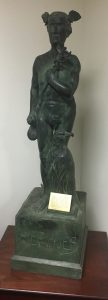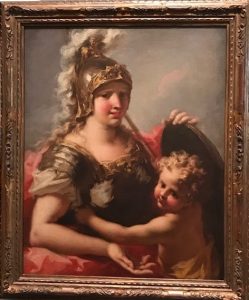
Sculptor: The creator of this statue of Hermes is Peter Mansbendel, who was born in Switzerland, and later moved to Austin, Texas. He always longed to be a woodcarver, and through his career became noted in the Texas area for his work. Outside of the Hermes statue, he also created the carved doors of the Spanish Governor’s Place.
Date of Creation: 1922
Location on Campus: BBA Office in McCombs School of Business
Reason for Creation: In 1922, students at the UT McCombs School of Business chose Hermes as the patron saint of the school. Although Hermes was chosen, he actually takes on many of the spheres of influence more attributed to Mercury, who was representative of excellence in business, and his sphere of influence included trade and merchants. This is not uncommon in Roman culture, as Romans made equivalencies between their own gods and Greek gods (Buxton, p. 218). It’s possible that the artist took aspects of both Hermes and Mercury in his rendering of this statue. Nonetheless, this Hermes statue used to be brought to the yearly business banquet, but now sits in the BBA office in McCombs, inspiring business students.
Description: Mansbendel’s statue of Hermes is 38-inch tall wooden sculpture made of pine. It depicts Hermes as a nude young man with an athletic body, which is reflective of the appearance Hermes had in the Classical period. Hermes is seen with many symbols/objects commonly that associated with him in Greek and Roman myth. In his left hand, he holds a caduceus near his heart, which is a defining feature for him. A caduceus is a staff, typically golden, and is a symbol of Hermes’ role as the herald/messenger of the gods. The staff is often shown with two entwined snakes (Pseudo-Hyginus, Astronomica 2.7). This well known object is representative of Hermes, and also his roles/spheres of influence, such as trade, or business. Hermes is also wearing winged sandals and a winged helmet, which was a common attribute of Hermes in Classical Greek art, as it represented his sphere of influence as the god of movement (Pseudo-Apollodorus, Bibliotheca 2. 37 & 46; Homer, Iliad 24. 339 ff; Buxton, p. 69). Additionally, Mansbendel uses other symbols that are more modern to reflect business today. In Hermes’ right hand, he is holding a bag of money. This is still associated with Hermes’ sphere of influence of trade and merchants, and a well known symbol of commerce like a bag of money would make it more apparent that the role of Hermes in this case is to be the patron saint of a business school. Finally, there is a bird of prey at Hermes’ feet. In the Homeric Hymn to Hermes, Zeus named Hermes lord of all birds of prey, and one of Hermes’ sacred animals is a hawk (Homeric Hymn to Hermes, 560). However, the hawk can also be interpreted as an American eagle, which makes this statue of Hermes to be seen American despite its roots in Greek/Roman culture. This is an act of cultural appropriation, with the goal of further connecting Hermes to American business and making his role more relevant to McCombs students. Although this statue of Hermes features many aspects and symbols associated with Hermes from Classical Greek myth, Mansbendel combines modern themes to emphasize Hermes’ relation to business excellence.
Bibliography:
- Buxton, R. G. A. The Complete World of Greek Mythology . London: Thames & Hudson,
2016. - Homeric Hymn to Hermes
- Homer, Iliad
- Nicar, Jim. “100 Years in 10 Objects.” McCombs Magazine, October 17, 2016, 24.
- Pseudo-Apollodorus, Bibliotheca
- Pseudo-Hyginus, Astronomica
Written by Olivia Lin


